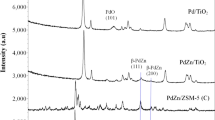Abstract
During the H2O/CO2 co-splitting, ZnO crystals were formed by oxidation of Zn giving gaseous product, H2/CO. Micrographs of Zn/ZnO and temperature program reaction (TPRx) of H2O/CO2 splitting showed that the crystal growth was occurred via two phenomena; (1) surface reaction: at temperature from 400 to 550 °C, H2O/CO2 oxidized Zn resulting in the outward growth of the ZnO crystals until the whole surface became inert and totally covered all the unreacted Zn inside the core. At this point, the production rates of H2/CO were temporarily paused; (2) phase changing and core-cracking/shrinking: at temperature 550–600 °C, Zn particles inside the core was phase-changed from solid to liquid/vapor due to the higher temperature. The higher pressure inside the core led to core-cracking, where the Zn travelled to the surface to continue reacting with H2O/CO2. Core-shrinking was then occurred due to the crack of ZnO shell and leakage of Zn. TPRx results showed that CO2 competed H2O in adsorption/dissociation on the Zn during temperature from 400 to 550 °C. Conversions and kinetic parameters were experimental and mathematical determined. The apparent activation energy of H2O and CO2 splitting on Zn/ZnO particles was estimated at 77.63 and 51.11 kJ/mol, while the pre-exponential factors were determined at 4.02 and 0.30 s−1, respectively.






Similar content being viewed by others
References
Price RJ, Morse DA (2004) Modeling the direct solar conversion of CO2 to CO and O2. Ind Eng Chem Res 43:2446–2453
Zhan Z, Kobsiriphat W (2009) Syngas production by coelectrolysis of CO2/H2O: the basis for a renewable energy cycle. Energy Fuels 23:3089–3096
Singh V, Beltran IJ (2014) Photocatalysis deconstructed: design of a new selective catalyst for artificial photosynthesis. Nano Lett 14:597–603
Smestad GP, Steinfeld A (2012) Review: photochemical and thermochemical production of solar fuels from H2O and CO2 using metal oxide catalysts. Ind Eng Chem Res 51:11828–11840
Marxer D, Furler P (2015) Demonstration of the entire production chain to renewable kerosene via solar thermochemical splitting of H2O and CO2. Energy Fuels 29:3241–3250
Xu B, Bhawe Y (2013) Spinel metal oxide-alkali carbonate-based, low-temperature thermochemical cycles for water splitting and CO2 reduction. Chem of Mat 25:1564–1571
Loutzenhiser PG, Meier A (2010) Review of the two-step H2O/CO2-splitting solar thermochemical cycle based on Zn/ZnO redox reactions. Materials 3:4922–4938
Graf D, Monnerie N (2008) Economic comparison of solar hydrogen generation by means of thermochemical cycles and electrolysis. Int J Hydrog Energy 33:4511–4519
Meier A, Steinfeld A (2004) Solar fuels and materials. Enc Energy 5:5623–5637
Venstrom L, Krueger K (2009) Solar thermal electrolytic process for the production of Zn from ZnO: an ionic conductivity study. J Solar Energy Eng 131:0310051–0310059
Kodama T, Gokon N (2007) Thermochemical cycles for high-temperature solar hydrogen production. Chem Rev 107:4048–4077
Chueh WC, Falter C (2010) High-flux solar-driven thermochemical dissociation of CO2 and H2O using nonstoichiometric ceria. Science 330:1797–1801
Stamatiou A, Loutzenhiser PG (2010) A solar syngas production via H2O/CO2-splitting thermochemical cycles with Zn/ZnO and FeO/Fe3O4 redox reactions. Chem Mat 22:851–859
Stamatiou A, Loutzenhiser PG (2012) A syngas production from H2O and CO2 over Zn particles in a packed-bed reactor. AIChE J 58:625–631
Monshi A, Foroughi MR (2012) Modified scherrer equation to estimate more accurately nano-crystallite size using XRD. World J Nano Sci Eng 2:154–160
Wu SF, Lan PQ (2012) A kinetic model of nano-CaO reactions with CO2 in a sorption complex catalyst. AIChE J 58:1570
Chiron FX, Patience GS (2012) A kinetic model of nano-CaO reactions with CO2 in a sorption complex catalyst. Int J Hydrog Energy 37:10526–10538
Acknowledgements
Grants from PTT Public Company Limited, Thailand Research Fund (TRG5880059) and National Research Council of Thailand (KMUTNB-GOV-57-43) are acknowledged for the support.
Author information
Authors and Affiliations
Corresponding author
Rights and permissions
About this article
Cite this article
Tongnan, V., Sornchamni, T., Laosiripojana, N. et al. Study of crystal growth and kinetic parameters of Zn/ZnO oxidation in the presence of H2O and CO2. Reac Kinet Mech Cat 125, 99–110 (2018). https://doi.org/10.1007/s11144-018-1411-3
Received:
Accepted:
Published:
Issue Date:
DOI: https://doi.org/10.1007/s11144-018-1411-3




